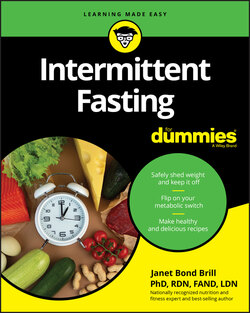Читать книгу Intermittent Fasting For Dummies - Janet Bond Brill - Страница 48
Expending your calories out
ОглавлениеWeight control is all in the calorie math. To lose weight, you must make changes in both your food intake and exercise patterns such that you reduce your calorie intake below your energy expenditure. When calculating your ideal calorie range to achieve your goals, you need to know a little more about what make ups your energy expenditure side of this equation.
Weight loss = Weekly calories burned greater than weekly calories eaten
Your body burns calories in several ways. To figure out exactly how many you burn each day, also known as your total daily energy expenditure (TDEE), you need to know your basal metabolic rate (BMR) and your general activity level. (The thermic effect of the food (TEF) or the calories burned to metabolize the food you eat also contributes to your TDEE, contributing up to 10 percent.)
Your BMR is the number of calories your body uses while at rest to do the stuff that keeps you alive like breathing; circulating blood; and controlling body temperature, cell growth, brain and nerve function, and contraction of muscles. Your BMR accounts for roughly 60 percent of your daily calorie expenditure. BMR varies from person to person. Factors affecting BMR include your body weight, your height, your gender, your percent body fat and muscle mass, your body temperature, your age, your hormone levels, and your genetic predisposition. Unfortunately, you don’t have much control over your BMR.
Figure 3-1 categorizes the calorie burn side of the equation. The remaining 30 percent of TDEE is physical activity, which then gets broken down into exercise activity thermogenesis (EAT) and nonexercise activity thermogenesis (NEAT). EAT accounts for about 5 percent of TDEE, whereas NEAT can contribute as much as 15 percent. You can see how you have a great deal of control over your dual activity levels, the calorie-burning furnaces: your NEAT and EAT.
© John Wiley & Sons, Inc.
FIGURE 3-1: Breaking down your total daily energy expenditure.
